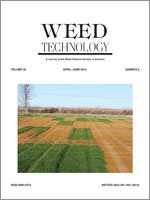Johnsongrass is a troublesome weed infesting spring–summer crops. Poor control of johnsongrass after fluazifop-p-butyl treatments has been reported in central to northern Italy. Greenhouse and outdoor dose–response experiments revealed that four populations were highly resistant to fluazifop-p-butyl. All four were cross-resistant to other aryloxyphenoxypropionate (FOP) herbicides—propaquizafop, quizalofop, and haloxyfop. The resistance indexes ranged between 8 and 25 for propaquizafop and quizalofop, whereas a greater variability between populations was detected in response to haloxyfop. Conversely, cycloxydim and clethodim determined only a shift in the susceptibility with resistance index (RI) values of 2 to 3. Molecular analyses revealed that resistant plants possessed an insensitive acetyl coenzyme-A carboxylase (ACCase) target enzyme due to an Ile-to-Asn substitution at codon 2041. To our knowledge, this is the first report of such a mutation endowing ACCase resistance in johnsongrass. A molecular marker (CAPS assay) was developed for its rapid detection. Alternative mode of action herbicides S-metolachlor and nicosulfuron controlled all the FOP-resistant populations. Only a few chemical options are still available, and they have different efficacy on germinating seeds and sprouting rhizomes. To maintain efficacy over time, herbicides should be integrated with agronomic practices.
Nomenclature: Fluazifop-p-butyl; propaquizafop; quizalofop; haloxyfop; cycloxydim; clethodim; S-metolachlor; nicosulfuron; johnsongrass, Sorghum halepense (L.) Pers.
Sorghum halepense es una maleza problemática que infesta cultivos de primavera y verano. En el centro y norte de Italia se ha reportado un control pobre de S. halepense después de tratamientos con fluazifop-p-butyl. Experimentos de respuesta a dosis en invernadero y al aire libre revelaron que cuatro poblaciones fueron altamente resistentes a fluazifop-p-butyl. Las cuatro poblaciones tuvieron resistencia cruzada a otros herbicidas aryloxyphenoxypropionate (FOP), tales como propaquizafop, quizalofop, y haloxyfop. Los índices de resistencia variaron entre 8 y 25 para propaquizafop y quizalofop, mientras que se detectó una mayor variabilidad entre poblaciones en respuesta a haloxyfop. En cambio, cycloxydim y clethodim determinó solamente una cambio menor en la susceptibilidad con valores del índice de resistencia (RI) de 2 a 3. Análisis moleculares revelaron que las plantas resistentes poseían una enzima acetyl coenzyme-A carboxylase (ACCase) insensible debido a una sustitución de Ile por Asn en el codón 2041. Con base en nuestro conocimiento, este es el primer reporte de esta mutación que confiere resistencia a ACCase en S. halepense. Un marcador molecular (ensayo CAPS) fue desarrollado para la detección rápida de la mutación. Herbicidas con modos de acción alternativos, como S-metolachlor y nicosulfuron controlaron todas las poblaciones resistentes a FOP. Solamente unos pocas opciones químicas están todavía disponibles, y estas tienen diferente eficacia sobre semillas germinadas y rizomas rebrotados. Para mantener la eficacia a lo largo del tiempo, estos herbicidas deberían ser integrados con prácticas agronómicas.





